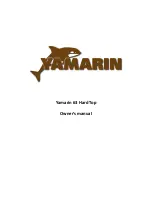
Section 07
ELECTRICAL SYSTEM
Sub-Section 03
(CHARGING SYSTEM)
07-03-4
BATTERY
Troubleshooting
Removal
Proceed as follows:
1. Disconnect the BLACK negative cable first.
2. Disconnect the RED positive cable last.
3. Remove the vent line from the battery.
4. Remove the holding strap(s).
5. Withdraw battery from watercraft being careful
not lean it so that electrolyte flows out of vent
elbow.
Cleaning
Clean the battery casing, caps, cables and battery
posts using a solution of baking soda and water.
Remove corrosion from battery cable terminals
and battery posts using a firm wire brush. Rinse
with clear water and dry well.
Inspection
Visually inspect battery casing for cracks or other
possible damage. If casing is damaged, replace
battery and thoroughly clean battery tray and
close area with water and baking soda.
Inspect battery posts for security of mounting.
Inspect for cracked or damaged battery caps, re-
place defective caps.
Electrolyte Level
Check electrolyte level in each cell, add distilled
water up to upper level line.
Hydrometer Test
A hydrometer measures the charge of a battery in
terms of specific gravity of the electrolyte. Most
hydrometers give a true reading at 21
°
C (70
°
F).
SYMPTOM: DISCHARGED OR WEAK BATTERY
CAUSE
REMEDY
1. Battery posts and/or
cable terminal oxi-
dized.
Clean and coat with
dielectric grease.
2. Loose or bad
connections.
Check wiring and
connector cleanliness,
damaged or short circuit.
3. Faulty battery
(sulfated, doesn’t
keep a full charge,
damaged casing,
loose post).
Replace.
4. 15 amp fuse(s) burnt
or faulty rectifier.
First check fuse.
If it is in good condition,
check rectifier/regulator.
5. Faulty battery
charging coil (or
stator).
Replace.
◆
WARNING
Battery BLACK negative cable must always
be disconnected first and connected last.
Never charge or boost battery while in-
stalled in watercraft.
◆
WARNING
Electrolyte is poisonous and dangerous.
Avoid contact with eyes, skin and clothing.
Wear a suitable pair of non-absorbent
gloves when removing the battery by hand.
-
CAUTION
Should any electrolyte spillage occur, imme-
diately wash off with a solution of baking
soda and water.
-
CAUTION
Do not allow cleaning solution to enter bat-
tery.
◆
WARNING
Battery caps do not have vent holes. Make
sure that vent line is not obstructed.
-
CAUTION
Add only distilled water in an activated bat-
tery.
www.SeaDooManuals.net
Summary of Contents for 1997 GSI
Page 1: ...www SeaDooManuals net ...
Page 2: ...0 0 SHOP MANUAL 0 219 100 048 www SeaDooManuals net ...
Page 343: ...www SeaDooManuals net ...
Page 344: ...www SeaDooManuals net ...
Page 345: ...www SeaDooManuals net ...
Page 346: ...www SeaDooManuals net ...
Page 347: ...www SeaDooManuals net ...
Page 348: ...www SeaDooManuals net ...
Page 349: ...www SeaDooManuals net ...
Page 350: ...www SeaDooManuals net ...
Page 351: ...www SeaDooManuals net ...
Page 352: ...www SeaDooManuals net ...
Page 353: ...www SeaDooManuals net ...
Page 354: ...www SeaDooManuals net ...
Page 355: ...www SeaDooManuals net ...
Page 356: ...www SeaDooManuals net ...
Page 357: ...www SeaDooManuals net ...
Page 358: ...www SeaDooManuals net ...
Page 359: ...www SeaDooManuals net ...
Page 360: ...www SeaDooManuals net ...
Page 361: ...www SeaDooManuals net ...
Page 362: ...www SeaDooManuals net ...
Page 363: ...www SeaDooManuals net ...
Page 364: ...www SeaDooManuals net ...
Page 365: ...www SeaDooManuals net ...
Page 366: ...www SeaDooManuals net ...
Page 367: ...www SeaDooManuals net ...
Page 368: ...www SeaDooManuals net ...
Page 369: ...www SeaDooManuals net ...
Page 370: ...www SeaDooManuals net ...
Page 371: ...www SeaDooManuals net ...
Page 372: ...www SeaDooManuals net ...
















































